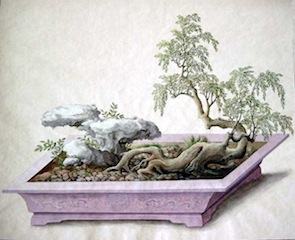Why
do we do bonsai?
I had a light bulb moment during the recent beginner’s class sponsored by the Columbus Bonsai Society. Tom, Dan and myself have been leading this class for a number of years
( we think this was the sixth edition, but we are not sure). It is always a
great way to spend a Saturday, and this year was no exception.
 |
| Pen-ching, the Chinese forerunner of Bonsai |
 |
| Tons of Blue and White pottery was produced for the export market. |
Each instructor has certain topics that they are assigned to
present, and Dan is leadoff batter, getting the day started each year with an
over-view of bonsai history. Dan asked the rhetorical question “Why do we
do bonsai, rather than pen-ching?” That’s an interesting point that until that
moment had not really considered-why did the Japanese version of miniature
trees gain popularity in this country and around the world, when the Chinese
variant-from which the Japanese grew-is much less familiar ( and is often
called Chinese bonsai).
The light bulb moment was Dan considering that at the end of the
19th century, these two countries were in very different positions.
Japan was increasingly open to the west and was actively modernizing its
social, political and economic systems, while China in the same period was
doing the exact reverse.
Its
never easy to be a new immigrant, but Chinese in this country had an especially
hard time. It certainly seems possible that Japanese immigrants occupied a
different , somewhat higher social position; where it was more ‘acceptable’ to
the general population to be aware of and even take in interest in facets of
Japanese culture. Considering the fact
that the nation was forced to accept trade and diplomacy with the west, Japan embraced
the situation whole heatedly. When American and European consumers expressed
an interest in Japanese goods, and wanted to buy them, Japanese manufacturers
ramped up production of everything from fabric to ceramics especially for these
new markets.
The
mania for all things Japanese is recorded in Impressionist art of the time.
Gilbert & Sullivan wrapped a thoroughly English story in a Japanese mask
and created The Mikado, a piece of musical theatre that is still popular today.
Every fashionable lady bought imported silks and would have had a display of
blue and white “willowware” in her parlour. Reminders of Japanese arts and
culture where literally everywhere.
 |
| Japanese Pavilion at the 1878 Paris World's Fair |
And
this was the era when the west was introduced to bonsai. World’s Fairs in London
and Paris features bonsai amongst the Japanese pavilions, and America’s
Centennial Exhibition in Philadelphia is likely the first ‘ bonsai show’ on
this continent. Contrast that with the low social status of Chinese at the
time, and the adoption of bonsai over
pen-ching may be ore apparent.
No comments:
Post a Comment